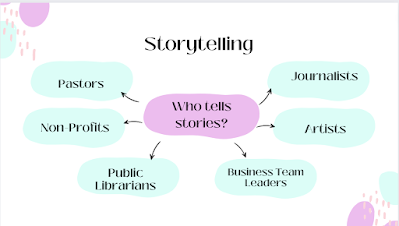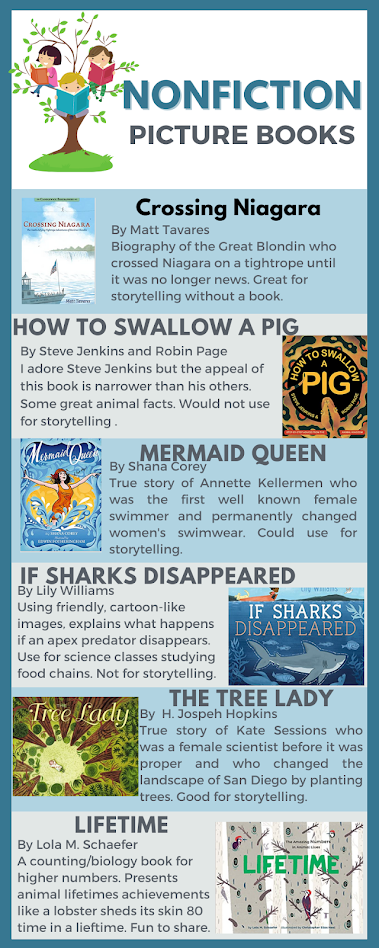Wells_Laura_Blogshare
As I've explored blogs on storytelling, I am amazed at how many of them are nonprofits with storytelling workshops. They are localized, not international. Consider the Young Storyteller's group in CA. It looks like a super successful program that is mentor based. Or Patchwork: A Storytelling Guild based in PA, that seeks to promote the oral telling of stories. At first, I was confused by the locality of these sites, why not serve the whole country? Then I remembered that storytelling promotes community.
 |
| Web of who appears to recognize the value of storytelling |
testimonies from participates. Participates range from big name companies like
Google or Nike to pastors, non-profits, and insurance sales teams. I kept wondering, why, until this class, has storytelling never been taught to me? As a high school English teacher, I would think storytelling would be taught. Why are businesses and non-profits recognizing the value of good storytelling, but not education? Or was my education unique? Did other teachers learn about storytelling prior to this class?
One of the storytelling organization that markets storytelling to a large audience all
over the US and to businesses like Google and Nike is the The Moth. When I was Googling storytelling techniques, its website came up as an ad. I thought it sounded vaguely familiar. I realized I had heard the program once on a long car trip on NPR. I had loved it, but I never knew what the program was called. Turns out, The Moth is a hugely influential storytelling program that has been creating storytelling events across the country for 25 years. Usually a weekly program, it features the best stories told in the various official Moth events around the country; usually the stories focus on a general theme like surprises, fear, or moving. Usually the storytellers are adults. Naturally, if you miss the weekly program in your area, you can just listen to the podcasts. When needed they provide warning about the age appropriateness of the story. The podcast also provides bleeped versions so younger audiences or those who dislike swear words will still listen.
over the US and to businesses like Google and Nike is the The Moth. When I was Googling storytelling techniques, its website came up as an ad. I thought it sounded vaguely familiar. I realized I had heard the program once on a long car trip on NPR. I had loved it, but I never knew what the program was called. Turns out, The Moth is a hugely influential storytelling program that has been creating storytelling events across the country for 25 years. Usually a weekly program, it features the best stories told in the various official Moth events around the country; usually the stories focus on a general theme like surprises, fear, or moving. Usually the storytellers are adults. Naturally, if you miss the weekly program in your area, you can just listen to the podcasts. When needed they provide warning about the age appropriateness of the story. The podcast also provides bleeped versions so younger audiences or those who dislike swear words will still listen.
I love the guidelines for Moth stories as they preserve the oral tradition of storytelling. Here are some of the guidelines: stories must true, they have to be told (not read), they should have a great first line, no fake accents, no rants, it must have a stake (how did the story change you). If I think about teaching storytelling in the library classes, I love these guidelines. I think I would add appropriate for school to the list.
If you venture over the to The Moth website, you will see that they have a Moth blog called Dispatches from the Moth. On the left of the blog, it lists categories and at the bottom of the list is "storytelling school." There are 50 posts under this category. These posts are part of storytelling workshops the Moth does with high school students. The featured storyteller is often a student from the workshop or sometimes a famous teen. .I found all the lessons to be useful and especially appreciated how each school session features a 6-8 minute story, usually by a young person, that shows a certain trait of storytelling done well. Following the story are ideas for discussion, ideas for creating your own story, and an activity.
Today, I want to highlight lesson #34 . The lesson focuses on delivery, and the featured storyteller is Amanda Gorman, who is just amazing. I love this lesson for 3 reasons. 1) Amanda Gorman. Amanda Gorman. Amanda Gorman 2) Students don't understand delivery; they don't understand the importance of your body and how it can enhance or detract from a story. 3) In addition to body, the lesson touches on repetition and pauses, which are major parts of good storytelling. Amanda does all these techniques well.
I think I could use this lesson in a high school library, but it also a great resource to share with English teachers as they teach poetry. I love that the example stories are told by young people.
Readings for the Week (complete list of stories/poems at bottom of post):
Ghost stories. There is so much appeal to me in learning ghost stories because they are often intended to be shared in a group and do not depend on pictures. Plus, across grade levels, scary stories are a highly sought after. I read two
collections of ghost stories. The Classic Ghost Stories book had well known creepy stories from authors like Poe, Bierce or Doyle. These were creepy, but would be hard for me to retell without memorizing word for word because the literary quality of the words is a defining aspect of these stories. As a storytelling, I much prefer the book Campfire Ghost Stories. I could tell these stories without memorizing every word. They felt more like folktales where variations would be normal. And the book was arranged by setting: Stories for a campfire, stories for the dark, stories for candlelight. They were not too scary. I 'd say this book has tons of potential.
collections of ghost stories. The Classic Ghost Stories book had well known creepy stories from authors like Poe, Bierce or Doyle. These were creepy, but would be hard for me to retell without memorizing word for word because the literary quality of the words is a defining aspect of these stories. As a storytelling, I much prefer the book Campfire Ghost Stories. I could tell these stories without memorizing every word. They felt more like folktales where variations would be normal. And the book was arranged by setting: Stories for a campfire, stories for the dark, stories for candlelight. They were not too scary. I 'd say this book has tons of potential.
For poems, I challenged myself to read poets from the children's section that I
had not read. That took Shel Silverstein out. My favorites were the revolting fairy tale poems in Roald Dahl's Revolting Rhymes. But these poems were 3-5 pages long. Since poems need to be memorized word for word, these poems would take me a while to master. For storytelling, the best book was Rolling in the Aisle: A Collection of Laugh-Out-Loud Poems. It featured poetry by many poets and was lots of fun.
had not read. That took Shel Silverstein out. My favorites were the revolting fairy tale poems in Roald Dahl's Revolting Rhymes. But these poems were 3-5 pages long. Since poems need to be memorized word for word, these poems would take me a while to master. For storytelling, the best book was Rolling in the Aisle: A Collection of Laugh-Out-Loud Poems. It featured poetry by many poets and was lots of fun.








Hi Laura!
ReplyDeleteI enjoyed reading your blog this week! Like you, I have wondered why there was not more of an emphasis on storytelling when I was working to get my teaching degree. I think it would be a great class for education majors! It is amazing how many big companies have invested in storytelling. That goes to show you just how powerful stories can be. I also enjoyed exploring The Moth’s website and blog that you shared. There are some really amazing resources there for everyone, especially teachers and librarians! I absolutely loved the lesson you shared with Amanda Gorman. She is amazing, and the story that she shared was great!
Amy Sutherland